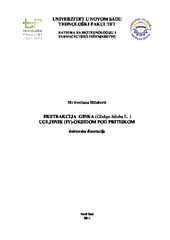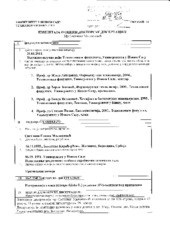Prikaz osnovnih podataka o disertaciji
Ekstrakcija ginka (Ginkgo biloba L.) ugljenik (IV)-oksidom pod pritiskom
Extraction of Ginkgo biloba L.by carbon (IV) –oxide under pressure
| dc.contributor.advisor | Lepojević, Žika | |
| dc.contributor.other | Zeković, Zoran | |
| dc.contributor.other | Lepojević, Žika | |
| dc.contributor.other | Veljković, Vlada | |
| dc.contributor.other | Popov, Stevan | |
| dc.creator | Milošević, Svetlana | |
| dc.date.accessioned | 2018-10-03T14:23:40Z | |
| dc.date.available | 2018-10-03T14:23:40Z | |
| dc.date.available | 2020-07-03T13:52:51Z | |
| dc.date.issued | 2011-05-27 | |
| dc.identifier.uri | https://nardus.mpn.gov.rs/handle/123456789/9962 | |
| dc.identifier.uri | https://www.cris.uns.ac.rs/DownloadFileServlet/Disertacijadisertacija.pdf?controlNumber=(BISIS)76803&fileName=disertacija.pdf&id=68&source=NaRDuS&language=sr | sr |
| dc.identifier.uri | https://www.cris.uns.ac.rs/record.jsf?recordId=76803&source=NaRDuS&language=sr | sr |
| dc.identifier.uri | https://www.cris.uns.ac.rs/DownloadFileServlet/IzvestajKomisije152412817420146.pdf?controlNumber=(BISIS)76803&fileName=152412817420146.pdf&id=11195&source=NaRDuS&language=sr | sr |
| dc.description.abstract | U okviru ove disertacije izvršeno je preparatvno izolovanje etarskog ulja lišća ginka (Ginkgo biloba L.) destilacijom pomoću vodene pare, u cilju određivanja pojedinih fizičko-hemijskih parametara. Oficinalnim postupkom određen je sadržaj etarskog ulja u lišću ginka i iznosi 0,0083%. Lišće ginka je ekstrahovano klasičnim rastvaračima tj. smešom alkohol-voda, pri čemu je koncentracija alkohola iznosila 40% (m/m). Primenom navedenog rastvarača, izvršena je višestupna protivstrujna ekstrakcija (u pet stupnjeva) pri čemu je dobijen tečni ekstrakt (Extracta fluida) sa relativno visokim sadržajem ekstraktivnih materija (17,06%). Tečni ekstrakt je direktno korišćen za dobijanje suvog ekstrakta lišća ginka (Extracta sicca)primenomvsušnie sa raspršivanjem (spray dryer). Kvalitativna i kvantitativna karakterzacija izvršena je primenom postupka tečne hromatografije na tankom sloju (HPTLC) i određen sadržaj ukupnih flavonoida sračunatih na rutin, a i na katehin, a određen je i sadržaj ukupnih fenola sračunatih na hlorogensku kiselinu. Glavni deo doktorske disertacije predstavlja ekstrakcija sistema lišće ginka-ugljenik (IV)-oksid pod pritiskom, pri čemu je ispitivan uticaj stepena usitnjenosti droge na prinos ekstrakcije, i korišćen koeficijent brze i spore ekstrakcije kao mera kinetičkog ponašanja ekstrakcije. Dobijeni rezultati ispitivanja su pokazali značajan uticaj stepena usitnjenosti droge na brzinu ekstrakcije, pogotovo, kod ekstrakcije natkritičnim ugljenik (IV) oksidom. Radi izbora optimalnog protoka ekstragensa ispitivani su sledeći protoci 0,095, 0,194 i 0,277 kg/h . Na osnovu prinosa ekstrakcije usvojeno je da je protok ekstragensa od 0,194 kg/h optimalan. Prinos ekstrakcije je ispitivan korišćenjem dva postupka ekstrakcije, i to: ekstrakcija tečnim ugljenik (IV) -oksidom (temperatura ispod kritične temperature Tc= 31,1oC, a pritisak nešto ispod ili iznad kritičnog pritiska pc=73,8 bar), i ekstrakcija natkritičnim ugljenik (IV)- oksidom (pritisak i temperatura iznad kritičnih vrednosti pritiska i temperature). U natkritičnoj oblasti promenom pritiska se značajno menjaju svojstva ekstragensa, povećava se sposobnost rastvaranja, dielektrična konstanta i dr. Ispitivan je uticaj temperature na prinos ekstrakcije (izotermni proces), pri čemu se dobijaju rezultati koji se ne mogu objasniti jednostavno, analizirajući samo uticaj gustine rastvarača na moć rastvaranja, već se za objašnjenje dobijenih rezultata uključuje i uticaj napona pare ekstrahovane komponente, tako da rastvorljivost komponente može da se poveća, smanji ili ostane ista sa povećanjem temperature na konstantnom pritisku, u zavisnosti koji uticaj je dominantniji. Kod izotermnih postupaka prinos ekstrakcije raste sa povećanjem pritiska ekstrakcije, što je u saglasnosti sa teoretskim principima. S druge strane, ekstrakti dobijeni pri višim pritiscima imaju manji sadržaj etarskog ulja što se objašnjava činjenicom da veći pritisci imaju veću moć rastvaranja glavnih komponenata kao i komponenata kao što su smole, voskovi i masna ulja. Kvalitativnom i kvantitativnom analizom selektovanih ekstrakata dobijenih tečnim (130 bar, 20oC, 3 h) i natkritičnim (100 bar, 40o C, 4 h) ugljenik (IV)-oksidom, kao i etarska ulja izolovana iz ovih ekstrakata nađeno je da ispitivani uzorci sadrže nalkane, račvaste alkane i jedinjenja sa kiseonikom, među kojima posebno mesto zauzimaju fenoli sa zasićenim i nezasićenim alkil ostacima. Izvršena je uporedna anliza etarskog ulja dobijenog destilacijom lišća ginka pomoću vodene pare i etarskih ulja dobijenih iz selektovanih ekstrakata. Interesantan je podatak koji se odnosi na sadržaj etarskog ulja u drogi određen direktnom destilacijom droge pomoću vodene pare i izdvajanjem etarskih ulja iz ekstrakata takođe destilacijom pomoću vodene pare. U ovom drugom slučaju dobija se, preračunavanjem, sadržaj etarskog ulja u drogi višestruko veći (4-10 puta) od sadržaja, određenog oficinalnim postupkom, u drogi. Ova pojava se objašnjava uvođenjem pojma „vezano“ etarsko ulje i „slobodno“ etarsko ulje. Ekstrakcijom ugljenik (IV)-oksidom pod pritiskom tzv. vezano etarsko ulje se oslobađa voskova i masnog ulja što se odražava na njegovu povećanu količinu u CO2-ekstraktima. Na kraju u ovoj disertaciji izvršeno je modelovanje ekstrakcionog sistema lišće Ginkgo biloba – ugljenik (IV)-oksid pod pritiskom korišćenjem model jednačine Naika i saradnika, modifikovane model jednačine Reverchon i Sesti-Osseo kao i model, češće korišćen, koji je predložila Sovová. Korišćeni modeli mogu relativno uspešno da se koriste za opisivanje ekstrakcionog sistema lišće Ginkgo biloba – ugljenik (IV)-oksid pod pritiskom. Radi iznalaženja najpovoljnijih uslova ekstrakcije primenjen je metod odzivne površine variranjem parametra ekstrakcije (pritisak, temperatura i vreme ekstrakcije). Na osnovu eksperimentalnih rezultata dobijen je polinom drugog reda za izračunavanje optimalnog prinosa ekstrakcije i određeni su najpovoljniji uslovi ekstrakcije kao i međusobni uticaji pojedinih parametra. | sr |
| dc.description.abstract | Within this thesis preparative isolation of essential oil from leaves of ginkgo (Ginkgo biloba L.) by steam distillation was carried out, in order to determine some physico-chemical parameters. The essential oil content in the leaves of ginkgo wass determined by an officinal procedure and its value is 0.0083%. Ginkgo leaves were extracted with conventional solvents, i.e. alcohol-water mixture, where the alcohol concentration was 40% (w/w). The forementioned solvent was used to carry out a multistage counter-current extraction (five stages) by which the liquid extract (Extracta fluida) with a relatively high content of extracts (17.06%) was obtained. The liquid extract was directly used to obtain a dry extract of ginkgo leaves (Extracta sicca) by spay drying. The qualitative and quantitative characterisation was based on the proceedings of liquid thin layer chromatography (HPTLC), the content of total flavonoids expressed as rutin, and as catechin, and the total phenol content expressed as chlorogenic acid was determined. The main part of the doctoral thesis is the extraction system of ginkgo leaves-carbon (IV) oxide under pressure, in which the effect of the drug particle size on the extraction yield was studied, and as a measure of the kinetic behavior of extraction the coefficient of fast and slow extraction was used. The obtained results showed a significant effect of the drug particle size on the speed of extraction, particularly, the extraction with supercritical carbon (IV) oxide. For the purpose of selecting the optimal flow of the solvent several flowrates were investigated 0.095, 0.194 and 0.277 kg/h. Based on the yield of extraction the solvent flowrate of 0.194 kg/h was assumed as optimal. The extraction yield was investigated using two extraction procedures: extraction with liquid carbon (IV) oxide (temperature below the critical temperature Tc = 31.1 0C and pressure slightly below or above the critical pressure pc = 73.8 bar), and extraction with supercritical carbon (IV) oxide (pressure and temperature above the critical values of pressure and temperature). In the supercritical area the change in pressure significantly the influences the properties of the solvent, increases the ability of dissolving, dielectric constant, etc. The effect of temperature on extraction yield was examined (isothermal process), where the obtained results can not be explained simply by analyzing only the effect of solvent density on the power of dissolution, but to explain these results the effect of vapor pressure of the extracted components must be included, so that the solubility of the component may increase, decrease or remain the same with increasing temperature at constant pressure, depending on which influence is dominant. In isothermal processes the extraction yield increases with increasing pressure of extraction, which is consistent with theoretical principles. On the other hand, extracts obtained at high pressures have a lower content of essential oils which can be explained by the fact that higher pressures have a greater power of dissolution of the main components as well as components such as resins, waxes and fatty oils. The qualitative and quantitative analysis of the selected extracts obtained with liquid (130 bar, 20 0C, 3 h) and supercritical (100 bar, 40 0C, 4 h) carbon (IV) oxide, and essential oils isolated from these extracts showed that the studied samples contain n-alkanes, branched alkanes and compounds with oxygen, including phenols with saturated and unsaturated alkyl residues. A comparative analysis of the essential oil obtained by distillation of ginkgo leaves by steam and essential oil obtained from selected extracts was carried out. An interesting fact concerning the essential oil content in the drug determined by direct distillation of drugs by steam and separating the essential oils from extracts also produced by steam distillation. In the other case, by calculation, the obtained essential oil content in the drug is several times higher (4-10 times) of content, determined by an fficinal procedure, in the drug. This phenomenon is explained by introducing the notion of "linked" essential oil and "free" essential oil. The extraction with carbon (IV) oxide under pressure the so called linked essential oil is released from waxes and fatty oils which is reflected in its increased amount in CO2-extracts. At the end of this dissertation the modeling of the extraction system leaves of Ginkgo biloba - carbon (IV) oxide under pressure was carried out using the model equation of Naik and associates, the modified model equation of Reverchon and Sesti Osseo and also like a frequently used model proposed Sovová. The mentioned models can be relatively used to describe the extraction system leaves of Ginkgo biloba - carbon (IV) oxide under pressure. In order to find the most favorable conditions of extraction, the response surface methodology varying extraction parameters was used (pressure, temperature and extraction time). Based on the experimental results a second order polynom for the calculation of the optimum yield of extraction was obtained and the extraction conditions and the mutual influence of some parameters were determined. | en |
| dc.format | application/pdf | |
| dc.language | sr (latin script) | |
| dc.publisher | Универзитет у Новом Саду, Технолошки факултет | sr |
| dc.rights | openAccess | en |
| dc.rights.uri | https://creativecommons.org/licenses/by-nc-nd/4.0/ | |
| dc.source | Универзитет у Новом Саду | sr |
| dc.subject | Ginko (Ginkgo biloba L.) ekstrakcija | sr |
| dc.subject | Ginkgo biloba L. extraction | en |
| dc.subject | carbon (IV)–oxide | en |
| dc.subject | essential oil | en |
| dc.subject | SX modelling | en |
| dc.subject | ugljenik (IV)-oksid | sr |
| dc.subject | etarsko ulje | sr |
| dc.subject | modelovanje ekstrakcije | sr |
| dc.title | Ekstrakcija ginka (Ginkgo biloba L.) ugljenik (IV)-oksidom pod pritiskom | sr |
| dc.title.alternative | Extraction of Ginkgo biloba L.by carbon (IV) –oxide under pressure | en |
| dc.type | doctoralThesis | en |
| dc.rights.license | BY-NC-ND | |
| dcterms.abstract | Лепојевић, Жика; Вељковић, Влада; Попов, Стеван; Лепојевић, Жика; Зековић, Зоран; Милошевић, Светлана; Екстракција гинка (Гинкго билоба Л.) угљеник (ИВ)-оксидом под притиском; Екстракција гинка (Гинкго билоба Л.) угљеник (ИВ)-оксидом под притиском; | |
| dc.identifier.fulltext | http://nardus.mpn.gov.rs/bitstream/id/39869/Disertacija17645.pdf | |
| dc.identifier.fulltext | http://nardus.mpn.gov.rs/bitstream/id/39870/IzvestajKomisije17645.pdf | |
| dc.identifier.fulltext | https://nardus.mpn.gov.rs/bitstream/id/39870/IzvestajKomisije17645.pdf | |
| dc.identifier.fulltext | https://nardus.mpn.gov.rs/bitstream/id/39869/Disertacija17645.pdf | |
| dc.identifier.rcub | https://hdl.handle.net/21.15107/rcub_nardus_9962 |



